“This meeting could have been an email.”
The meme has been around so long that it shows up superimposed over both an image of Manager Bill Lumbergh from the movie Office Space and the face of Michael Scott, Steve Carell’s iconic regional manager character from the tv show The Office. You can even buy stickers, candles and coffee mugs emblazoned with the slogan. Grousing about bad meetings has become a familiar part of the American workplace vernacular.
And while some of them surely could have been emails, meetings are an essential part of collaborative company culture and there are better and worse ways to facilitate them. Good facilitation requires care and attention, making sure everyone has opportunities to share in ways that feel comfortable to them.
At Everspring, holding meetings in varying formats helps ensure that everyone can find the context where they’re able to speak up. “This way, we can create a safe environment to determine the venue with which they are most comfortable sharing information and feedback,” Senior Vice President of Student Engagement Erin McGrane said.
MaryKate Larsen, corporate communications manager at Hireology, emphasized the necessity of creating a welcoming culture. “I think it’s all about psychological safety; creating a space for our employees to feel empowered to speak their minds and know they will feel heard, not punished,” she said.
Built In Chicago sat down with these leaders to learn more about making meetings productive and enjoyable, far less likely to be thrown in the “could have been an email” category.
Everspring partners with leading educational institutions and industry to design and scale high-quality online programs with an innovative approach.
How do you hold team meetings in a way that caters to how people feel most comfortable sharing their voice?
In the student engagement department, our focus is regular and varied meeting styles, in both type and size. We aim to fit the teams’ needs to create an environment that is transparent, accountable and supportive.
Each meeting includes a shared agenda which enables team members to collaborate and bring “walk-in” items for attention or discussion. We also reserve part of each meeting for any new “hot off the press” items to remain agile and fluid, so the team feels comfortable voicing their opinions or ideas.
We have a strong team with varied backgrounds and comfort levels in sharing information in group settings. Since we operate within a hybrid work modality, there are many ways we meet employees to instill trust and bring out their best work.
We hold meetings in full department groups, small groups (supervisor and direct reports) and one-on-one meetings. This way, we can create a safe environment to determine the venue with which they are most comfortable sharing information and feedback. We also encourage both cross client and cross functional cooperation to ensure we are connected across teams and partnerships which allows teams to see the “why” and the overarching goals.
What tools or technology are helpful in letting people share and amplify their voice during meetings?
When not in person, the technologies that we leverage in meetings to keep the lines of communication open are Google documents, agendas, Smartsheet, Zoom screen sharing, Slack chat, polls and surveys. These collaborative tools facilitate an efficient meeting with clear input and takeaways.
Culture and trust are important; employees need to feel “it never hurts to ask” when coming forward. We stress the importance of open lines of communication since without it, we are not solidifying the best working relationships we can as a productive team, company and culture.
Culture and trust are important; employees need to feel 'it never hurts to ask' when coming forward.”
Still, some individuals may have been burned in the past, so have a hard time trusting the organization. To combat this, Everspring has a standing open amnesty survey which is truly anonymous and allows them to submit questions in a worry-free setting.
How do you encourage participation from all team members without pushing them too far outside of their comfort zone?
I believe we firmly set this standard at the onset with the talent acquisition process. During the interview, our department underscores that we are a company that thrives on continuous improvement and innovation. We need our employees to be interested in writing and iterating the playbook, not simply following it, which opens the expectations for input and new ideas.
If we’re using Zoom, we have a “cameras on & unmute” philosophy which encourages the free flow of organic conversation and ideas. It also shows a level of respect for one another that demonstrates active listening, just as attentive as you would in person. It’s important to us and breeds connection and positive interaction.
My favorite quote by Maya Angelou is, “I’ve learned that people will forget what you said, people will forget what you did, but people will never forget how you made them feel.” I find these words to hold very true, and I try to live and be led by them.
Hireology helps HR professionals and recruiters attract, hire and retain talent in a single platform.
How do you hold team meetings in a way that caters to how people feel most comfortable sharing their voice?
Our goal at Hireology is to always have intentional, transparent and consistent communication across our organization. Not just top-down but also bottom-up communication.
All our meetings cater to both our remote employees and employees who have chosen to be in the office that day. We pride ourselves on creating a safe space in all of our meetings where employees can speak freely - live or remotely - if they have a question, need to give an update or have to present.
We host all-company Q&A sessions during our quarterly town halls, and all employees are encouraged to submit questions ahead of time and/or ask their questions live if they wish. On top of Q&A sessions, we implemented the OKR (objectives and key results) framework at the beginning of 2023 to help promote feedback and create unity and alignment across teams and the organization. We have monthly OKR meetings as well as quarterly OKR planning sessions where employees who have been on the ground doing the work can present their progress.
It opens up dialogue across other teams. Our rhythm of business also includes smaller weekly team meetings where answers or concerns can be addressed in a more intimate setting.
What tools or technology are helpful in letting people share and amplify their voice during meetings?
We utilize Zoom across our organization for all team and company meetings. Zoom has chat and Q&A features that we have found to be very beneficial not only for employees asking questions during meetings, but also interacting with peers at home or in person.
We also use Slack daily at Hireology. There are many channels dedicated to specific topics that employees use before, during and after meetings, whether it’s a technical question, giving a shoutout to a co-worker or celebrating wins large and small.
How do you encourage participation from all team members without pushing them too far outside of their comfort zone?
I think it’s all about psychological safety; creating a space for our employees to feel empowered to speak their minds and know they will feel heard, not punished. That’s why we have many different meetings and cadences so we can cater to various work styles and personalities.
I think it’s all about psychological safety; creating a space for our employees to feel empowered to speak their minds and know they will feel heard, not punished.”
This was a huge motivation for us when we rolled out OKRs at the beginning of the year. We knew it was important to create a collaborative goal-setting protocol for our teams and individuals, a management methodology that aligns the activities of employees at all levels to focus on the same priority goals, as well as a common language and critical thinking framework. Since putting the OKR framework in place, we’ve seen a tremendous increase in both ownership of work and the confidence to speak about that work.









